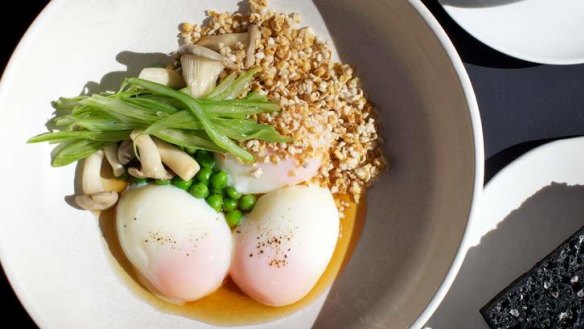Brent Savage's perfect poached eggs
Ah, the poached egg. It's a breakfast mainstay and an apt addition to almost any dish – but it has the power to intimidate even the fiercest of home cooks. Properly poached, the humble egg becomes otherworldly, its velvety sunshine centre oozing out over snowy white. But do it wrong and you’ll likely end up with watery egg soup.
Brent Savage, chef and co-owner of Bentley Restaurant and Bar, Monopole and Yellow in Sydney, knows a thing or two about eggs. As a first-year apprentice he was put on breakfast; poached eggs were the first dish he ever had sent back, owing to a heavy hand with the vinegar.
These days, Savage is all about the slow-cooked egg, poached in its shell for one hour at 63 degrees. It's a method used in Yellow's brunch dish of eggs with charred onion consommé, peas, mushrooms and toasted quinoa.
The 63-degree egg rose to power a couple of years back, thanks to the likes of Melbourne's Cumulus Inc. Chefs love it because it leaves nothing to chance.
"Using the traditional method is a highly skilled thing to do, especially if you've got as many eggs as we have on order," Savage says. "[Slow cooking] was a way of getting around that."
Savage believes slow cooking also produces a better result: translucent, quivering and silky smooth, with the yolk and white cooked uniformly.

But if you can't justify investing in an immersion circulator for the sake of a soft egg, you can also follow Savage's traditional method of poaching, requiring little more than a saucepan and a slotted spoon. You'll find both techniques below.
The egg matters
Before you start, know this: the quality and freshness of your egg matter. Firstly, organic free-range eggs just taste better. Secondly, if you use an old goog, the white won't coagulate, leaving you with straggly bits or – disaster of disasters – total egg disintegration.
The slow-cooking method
Heat the water in a temperature-regulated water bath, such as an immersion circulator, to 63 degrees. Submerge the eggs in the water for one hour, keeping the temperature constant.
After an hour, remove the eggs, then carefully crack them in half and slide onto a plate. Gently wipe away the membrane, and there you have it: glossy, perfect poachies.
Or you can try simply using a pot of water and a cook's thermometer. But that can be tricky to get right, and if the temperature varies by more than a few degrees, the egg white will stick to the shell.
The traditional method
For the average person who lacks time (and an obsession with perfection), there's always the traditional method. A quick Google search or flick through cookbooks will yield a variety of techniques and debates. Savage's tried-and-tested method uses a whirlpool of acidulated water, with no vinegar to be seen.
Instead, he recommends using lime juice – it has the same effect minus the vinegary taste. If you don't have limes on hand, 30ml of plain white vinegar to one litre of water is an acceptable alternative.
This method generally works for up to two eggs but beyond that things get dicey. If you're cooking several eggs it's best to use multiple saucepans.
Equipment
Small saucepan (1.6L filled with 1L of water)
Slotted spoon
Ingredients
1 lime (for every litre of water)
1 fresh, free-range egg
Method
Fill the saucepan with about one litre of water – enough to comfortably submerge the egg. Bring to the boil, reduce to a gentle simmer (about 90 degrees), then squeeze in the lime juice (or vinegar).
Meanwhile, crack the egg into a small bowl or ramekin.
Use a slotted spoon to swirl the water and create a whirlpool. Slowly and gently tip the egg into the centre. Use the spoon to gently keep the whirlpool going for about 30 seconds (but don't get too enthusiastic).
Leave the egg to cook for approximately two minutes (for a runny yolk). Use your judgment – you can tell how soft it is by giving the pot a bit of a shake or gently lifting the egg out with the spoon and giving it a prod (but more of an "Are you OK?" kind of nudge than a "WAKE UP" poke).
Once cooked, gently lift it out with the slotted spoon. To drain, hold absorbent paper under the spoon, rather than dropping the egg onto the paper. This will avoid tearing your egg. Serve however you like, though Savage recommends including a crunchy element to balance the egg's softness.
The best recipes from Australia's leading chefs straight to your inbox.
Sign upFrom our partners
Original URL: https://www.brisbanetimes.com.au/goodfood/recipes/brent-savages-perfect-poached-eggs-20140606-39n0z.html